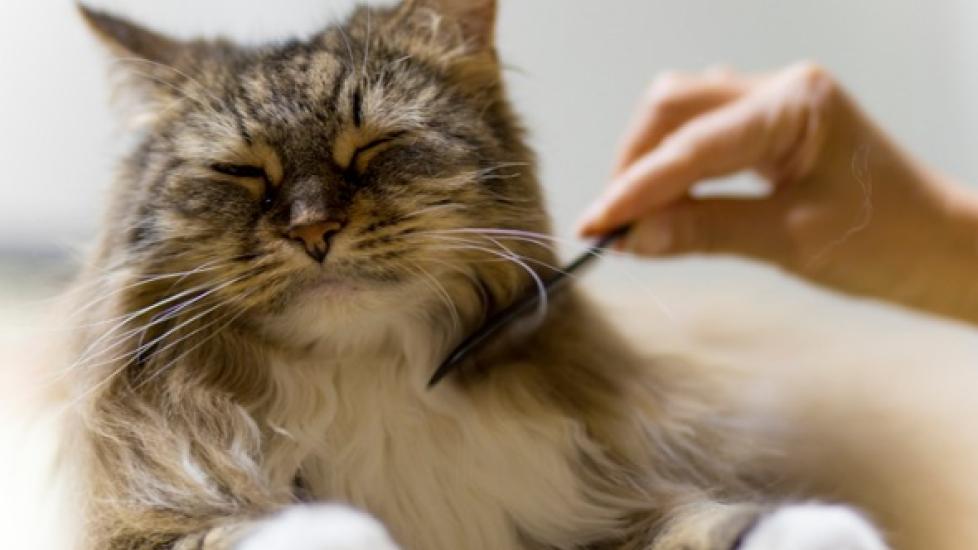How to Brush a Cat
If your cat is not used to regular grooming sessions, then she may not react so positively when you first try to brush her. Never try to force your cat to be brushed if she resists. If immediate grooming is vital, make an appointment with a professional groomer or veterinarian to evaluate the situation and perform it properly.
But if your cat does not protest too much, here are some expert recommendations on how to brush a cat at home and how to make it an enjoyable experience for both you and your kitty.
Preparing to Groom Your Cat
Before brushing, check the condition of your cat’s coat. Your cat’s coat should be free of bald patches or signs of fleas or signs of ticks. Her skin should also be free of unusual bumps, wounds or color changes. If something looks suspicious, it’s best to have your veterinarian take a look.
After you’ve made sure that your cat has no skin issues, you can prepare for your grooming session.
Rachel Diller, owner of Urban Sophisticats in Littleton, Colorado, certified feline master groomer and approved trainer for the National Cat Groomers Institute, recommends setting up the area with all the tools you need first. You don’t want to get your kitty in the right position and then scramble for tools when you realize you don’t have them.
Choose the Right Brush
Diller explains, “Cats typically have a variety of coat types. Their coats can be long, thick, thin, curly, dense, short and, of course, any combination based on their parents.”
Choosing the right cat brush depends on the type of fur you’re dealing with and what your cat prefers. Linda Schmoldt, groomer, owner of Spiffy Kitty Cat Grooming in New York and Fear-Free Certified Professional, says, “Pick a brush your cat likes. Try out a bunch of different ones. There are rubber brushes, rakes, slicker brushes and more.” Schmoldt also recommends trying the KONG Cat ZoomGroom multi-use brush for a massage-like experience.
Diller recommends using the Safari coarse comb and the Resco professional ergonomic comb for all hair types. She says, “I use both of these combs for all coat types. The only issue with longer hair is that you may pull more, unintentionally. So just go slow and easy; remember, you want the cat to enjoy this long-term.”
Basics for Brushing a Cat
Schmoldt recommends daily brushing for long-haired cats and weekly for short-haired cats.
Schmoldt says that the key to brushing a cat is figuring out the strategies that work for both of you. “Pick a calm, quiet time. Gently brush while providing treats or words of gentle encouragement. If kitty is wiggly, try different locations in the home or different times of day.”
When you’re ready to start the brushing session, Diller says, “I generally take a metal comb, (like the Resco professional combination comb) and start around the neck. You can gently hold the kitty around his/her shoulders at first.
Schmoldt explains, “Most cats enjoy being brushed around the head, neck and shoulders. Many cats dislike being brushed on the rear or underside, so be cautious brushing those areas, or you might get scratched.”
Diller agrees that “the most sensitive areas are under the armpits, belly, rear legs and especially the tail.”
Diller says that if you hit a snag with your comb, you should put the comb down and use your fingertips to pull the hair apart. You don’t want to stress your cat out by yanking on their coat.
“Don’t brush too hard or use jerky, rushed movement,” says Schmoldt. “Stop when kitty asks you to stop. Don’t force it.”
Dealing With Mats in Your Cat’s Coat
Mats in your cat’s coat are essentially clumps of knotted fur, and unlike a single tangle, they will feel like a dense piece of carpet in your cat’s otherwise soft fur.
Matting can range from minor to severe but is always irritating for your cat and should be safely removed. Brushing regularly can prevent mats from occurring in the first place.
If you’ve found a mat, Diller emphasizes the importance in safely using the proper tools or having a professional handle difficult mats. “Any kind of mat splitter has potential to slice the skin open under matted fur.”
Diller warns, “Never, ever take scissors to the knots. It’d be safer to just take the comb and gently but quickly pull the mat out of the hair. This, of course, depends on the mat’s severity.” If you’re unsure, its often best to let the experts take a look.
“When in doubt about how to brush your cat, hire a groomer. We’re here to help,” says Schmoldt.
Positive Reinforcement During Grooming Sessions Is Essential
Brushing is not only a chance to keep your cat’s fur looking fresh and clean and to reduce the amount of hair that’s shed around your home, but it’s also an opportunity to bond.
Make the brushing sessions relaxing and enjoyable by turning them into regular bonding activities. “Treats help. I like Hartz Delectables tube treats. You squeeze the tube—like toothpaste—and the kitty licks the end of the tube,” says Schmoldt.
When you treat your cat during a grooming session, they’ll begin to associate the experience with goodies, so they’re likely to be more willing next time you want to brush him.
By: Carly Sutherland
Featured Image: iStock.com/S_Kazeo
